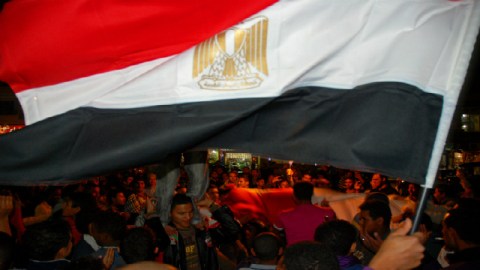Making Sense in Egypt

In the hours following the deaths of more than 50 Egyptians in Cairo earlier today there were wildly divergent accounts of what actually happened. Here is a summary, from Wendell Steavenson of the New Yorker:
The Islamists remained adamant that the Army fired on peaceful demonstrators. The Army says that they were provoked. Although many eyewitnesses and video clips corroborate some details—tear gas was fired by the Army at the start; gunfire came from at least some people on both sides, even if the Army did most of the shooting—there’s no clear indication of what sparked the violence. It is clear, however, that the vast majority of fatal injuries were caused by live ammunition, and that most of the dead were protesters. (An Army officer, a policeman, and a soldier were also reported killed.)
How people will interpret the evidence that is available – and how they will fill in the gaps – will depend largely on what they already believe. In Egypt, this will make the dead into martyrs for some and into terrorists for others, but the underlying psychology helps us to understand misunderstandings that occur regularly in our daily lives.
People are constantly interpreting reality – sometimes the facts in question are so clear that almost everyone generates a similar interpretation, but frequently reality is ambiguous. Take the license plate pictured below. Imagine that I told you it was banned by authorities in Colorado (which it was); how would you read it?
Now, what if I told you that the license plate’s owner was a committed vegetarian, would that change your interpretation?
According to the Denver Post (via Mental Floss), “FU” is on a list of proscribed letter combinations because the Department of Revenue says that, “some people could read that as street language for sex.” Meanwhile, poor Kelley Coffman-Lee’s ability to express her love for tofu has been curtailed, attracting the attention of the ACLU.
Psychologists call the act of interpretation construal, and when two people have different construals of the same situation it can lead to misunderstandings. Sometimes these misunderstandings become fodder for sitcoms; sometimes they lead to civil war. One seemingly trivial, but very instructive illustration of how different construals can drive behavior is captured in the findings of an experiment done with undergraduates at Stanford University by Varda Liberman, Steven Samuels, and Lee Ross.
Participants in the experiment played a prisoner’s dilemma game, in which they had to choose whether or not to cooperate with a partner. These are the rules: if you choose to cooperate, both you and your partner win a small amount of money (forty cents each). If you choose to cooperate but your partner does not, you lose twenty cents while your partner gets eighty (the payoff is the opposite if you do not cooperate but your partner does). Finally, if neither of you cooperate, nobody gets anything. Note that regardless of how your partner behaves, you always make more money by not cooperating, but that precludes you from settling on a cooperative solution which yields the highest overall payoff to both sides.
The twist that the researchers added to the standard version of the experiment is that half of the people in the study were told that the game was called the Wall Street Game while the other half were told it was called the Community Game. Even though the rules and payoffs were the same for everyone, the different names led to different construals of what was going on, which in turn led to dramatically different behavior. People playing the Community Game cooperated, on average, twice as frequently as people playing the Wall Street Game (roughly two-thirds vs. one-third of the time). Because of the different names given to the game people interpreted the situation very differently, and behaved in line with their interpretations.
In the Stanford study neither side’s interpretation was unreasonable given the information at people’s disposal. Similarly, returning to the streets of Cairo, it’s neither unreasonable of the Islamists to believe their members were massacred, nor for the army to believe that they were provoked. The big difference is where the divergent construals come from. In the prisoner’s dilemma experiment, different construals emerged from different names for the game and presumably the effects could be undone relatively easily. In Egypt people’s construals are much more deeply rooted, and therefore they are much more difficult to change. Once people are constrained by a deep commitment to a central belief, or ideology, it can systematically color their construals, which can quickly become unreasonable.
For example, Dan Kahan and his colleagues published a study(PDF) last year in the Stanford Law Review in which people with different political views first watched a video of a protest in which demonstrators clashed with police and then reported what they had seen. Critically, the experimenters told half the people the demonstrators were protesting against abortion rights, while they told the other half they were protesting the military’s “Don’t Ask Don’t Tell” (DADT) policy. People’s responses were not objective assessments of what took place, but were colored by their ideologically-driven construals of the situation. When liberally-minded people were told that they were watching a protest against abortion rights, they saw the protesters as much more hostile and aggressive and they reported that the police responded reasonably. When they were told that they were watching a protest against DADT, their opinions shifted dramatically; now they saw peaceful protesters being harassed by the police. Conservative-minded people showed the exact opposite pattern. Neither side could overcome the biased construal of the protest that magically transformed peaceful protestors into an angry mob, or vice versa.
As tensions continue to escalate in Egypt, we are likely to see a similar pattern. Supporters of the Muslim Brotherhood will affirm that today’s shooting was an unprovoked massacre by the army; their opponents will hold firmly to the contrary, insisting that the army was responding to an armed terrorist attack. If the situation is to be resolved diplomatically, all parties must recognize that their construals of the situation are not objective – as long as one side considers the dead to be terrorists, while the other side considers them martyrs, productive dialogue is not likely. The problem is that the sources of our construals are often invisible to us, and our biased perceptions feel like they’re objective. It’s always the other side that is spreading lies and twisting the truth to suit their nefarious agenda.
Below: Two tweets from Andrew Sullivan’s round-up of twitter reactions:
if the news about an army officer shot dead at #Rep_guard_house is true, I can see how this massacre happened.
— Marwa (@btnafas7oria) July 8, 2013
Couldn't find sympathy for MB anywhere. Everyone outside of Rabaa I've talked to doesn't believe Army fired on peaceful protesters
— Kristen Chick (@kristenchick) July 8, 2013






